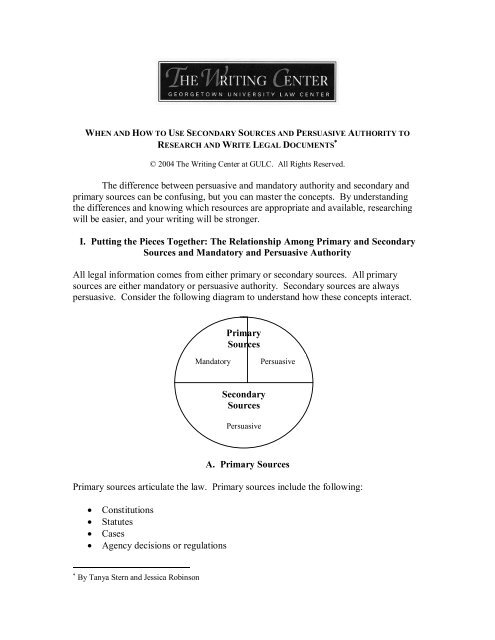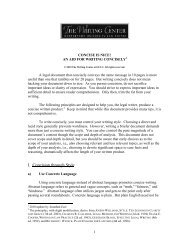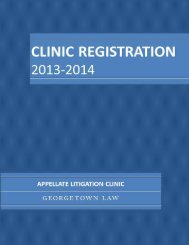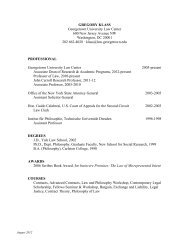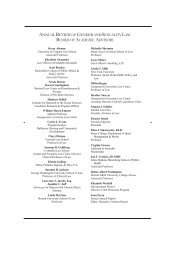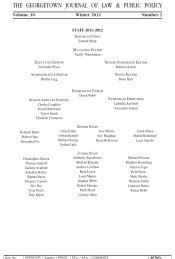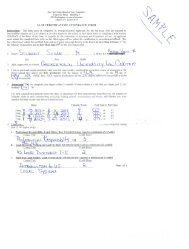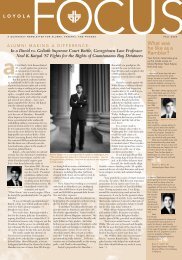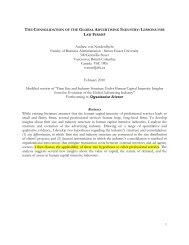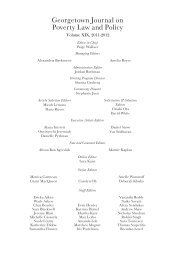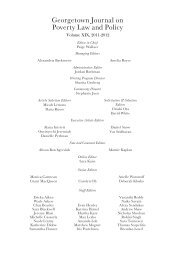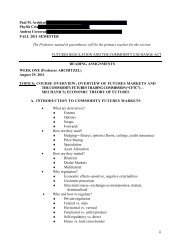Using Secondary Sources and Persuasive - Georgetown University ...
Using Secondary Sources and Persuasive - Georgetown University ...
Using Secondary Sources and Persuasive - Georgetown University ...
You also want an ePaper? Increase the reach of your titles
YUMPU automatically turns print PDFs into web optimized ePapers that Google loves.
WHEN AND HOW TO USE SECONDARY SOURCES AND PERSUASIVE AUTHORITY TO<br />
RESEARCH AND WRITE LEGAL DOCUMENTS ∗<br />
© 2004 The Writing Center at GULC. All Rights Reserved.<br />
The difference between persuasive <strong>and</strong> m<strong>and</strong>atory authority <strong>and</strong> secondary <strong>and</strong><br />
primary sources can be confusing, but you can master the concepts. By underst<strong>and</strong>ing<br />
the differences <strong>and</strong> knowing which resources are appropriate <strong>and</strong> available, researching<br />
will be easier, <strong>and</strong> your writing will be stronger.<br />
I. Putting the Pieces Together: The Relationship Among Primary <strong>and</strong> <strong>Secondary</strong><br />
<strong>Sources</strong> <strong>and</strong> M<strong>and</strong>atory <strong>and</strong> <strong>Persuasive</strong> Authority<br />
All legal information comes from either primary or secondary sources. All primary<br />
sources are either m<strong>and</strong>atory or persuasive authority. <strong>Secondary</strong> sources are always<br />
persuasive. Consider the following diagram to underst<strong>and</strong> how these concepts interact.<br />
A. Primary <strong>Sources</strong><br />
Primary sources articulate the law. Primary sources include the following:<br />
• Constitutions<br />
• Statutes<br />
• Cases<br />
• Agency decisions or regulations<br />
∗ By Tanya Stern <strong>and</strong> Jessica Robinson<br />
Primary<br />
<strong>Sources</strong><br />
M<strong>and</strong>atory <strong>Persuasive</strong><br />
<strong>Secondary</strong><br />
<strong>Sources</strong><br />
<strong>Persuasive</strong>
Primary sources can be either persuasive or m<strong>and</strong>atory. M<strong>and</strong>atory authority refers to<br />
cases, statutes, or regulations that the court must follow because it is binding on the court.<br />
Thus, lower courts are required to follow decisions from higher courts in the same<br />
jurisdiction.<br />
Example 1: You are in federal District Court for the Northern District of<br />
North Carolina. The same district court ruled that all dogs get two free<br />
bites, but the Fourth Circuit held that all dogs only get one free bite. The<br />
Fourth Circuit ruling is m<strong>and</strong>atory authority; therefore, you are out of luck<br />
if your client’s dog bit more than once.<br />
<strong>Persuasive</strong> authority refers to cases, statutes, regulations, or secondary sources that the<br />
court may follow but does not have to follow. Thus, the holding from a court in another<br />
jurisdiction or a lower court in the same jurisdiction is persuasive authority.<br />
Example 2: You are in federal District Court for the Northern District of<br />
North Carolina. The same district has not ruled on the dog issue <strong>and</strong><br />
neither has the Fourth Circuit. The Ninth Circuit, however, has ruled that<br />
hungry dogs can bite as many times as they want, <strong>and</strong> the Fifth Circuit has<br />
held that owners must euthanize all dogs that bite even once. You will<br />
want to argue that your court should adopt the Ninth Circuit’s rule;<br />
however, the district court may adopt either rule or make up its own rule.<br />
When writing a memo or a brief, you must cite to relevant m<strong>and</strong>atory authority.<br />
However, consider citing persuasive authority if no m<strong>and</strong>atory authority exists or<br />
adding support to the m<strong>and</strong>atory authority that you cited.<br />
As m<strong>and</strong>atory <strong>and</strong> persuasive authority are subsets of primary sources, reconsider<br />
Examples 1 <strong>and</strong> 2. In Example 1, the Fourth Circuit’s holding is primary<br />
authority <strong>and</strong> m<strong>and</strong>atory on the District Court for the Northern District of North<br />
Carolina. In Example 2, the Ninth Circuit <strong>and</strong> Fifth Circuit holdings are both<br />
primary authority, although they are considered persuasive to the District Court<br />
for the Northern District of North Carolina.<br />
B. <strong>Secondary</strong> <strong>Sources</strong><br />
While primary sources articulate the law, secondary sources analyze the law. For<br />
example, a Fourth Circuit case is a primary source, but an article analyzing that<br />
case is a secondary source. <strong>Secondary</strong> sources include the following:<br />
• Treatises<br />
• Dictionaries<br />
• Legal Encyclopedias like AmJur 2d <strong>and</strong> CJS<br />
• ALR<br />
• Restatements<br />
• Law Review Articles<br />
2
<strong>Secondary</strong> sources are never binding on a court. For example, while you might cite to the<br />
Restatement in a brief, the court will only consider it as persuasive authority <strong>and</strong> not as<br />
the binding, m<strong>and</strong>atory law.<br />
II. Putting These Ideas into Practice: <strong>Using</strong> <strong>Persuasive</strong> Authority <strong>and</strong> <strong>Secondary</strong> <strong>Sources</strong><br />
to Make the Research <strong>and</strong> Writing Process Easier<br />
First Year Legal Research <strong>and</strong> Writing <strong>and</strong> the USLD Program primarily focus on<br />
research <strong>and</strong> writing using primary, m<strong>and</strong>atory authority. <strong>Persuasive</strong> authority <strong>and</strong><br />
secondary sources are often overlooked, but many writers find these tools effective.<br />
A. Researching With <strong>Secondary</strong> <strong>Sources</strong><br />
<strong>Secondary</strong> sources are a helpful place to start research, especially if the assigned topic is<br />
unfamiliar. Writers can save a time researching because secondary sources provide an<br />
overview of the legal issues <strong>and</strong> point to relevant primary authority.<br />
Remember: No matter how promising the secondary sources may appear, you are<br />
There never are excused several from secondary reading sources <strong>and</strong> evaluating to use when primary you don’t sources know for yourself. anything about Authors the of<br />
topic: secondary sources are not infallible; the source may be biased or incomplete.<br />
Hornbooks: A hornbook will give you an overview of the relevant cases, regulations <strong>and</strong><br />
statutes for virtually any area of the law. Don’t forget to check the hornbook’s table of<br />
cases/statutes for citations to primary authority.<br />
Legal Encyclopedias: Like hornbooks, legal encyclopedias like CJS <strong>and</strong> AmJur 2d will<br />
provide useful background, inform the researcher of major cases <strong>and</strong> acquaint the reader<br />
with useful terminology. Statebased encyclopedias have the advantage of focusing on<br />
the law in a particular jurisdiction.<br />
American Law Reports (ALR): ALR is a collection of wellannotated subjects. While<br />
not all legal issues are included, an onpoint annotation can be very helpful by pointing<br />
you to multiple relevant cases. West Publishing has put out many editions of ALR <br />
ALR5th (Fifth Series) is the most uptodate <strong>and</strong> is significantly different from ALR4th,<br />
<strong>and</strong> ALR Federal includes only federal cases.<br />
Periodicals:<br />
If you are looking for information on a specific area of the law, you may want to<br />
start by looking for relevant articles on the subject. Indexes are a fast way to find<br />
relevant periodical articles. Some helpful indexes are the Index of Legal<br />
Periodicals (ILP), Index of Foreign Periodicals (IFLP) <strong>and</strong> the Legal Resource<br />
Index (LRI), which can be accessed through the library website, Lexis or<br />
Westlaw. Each index entry will contain a short summary of the article’s contents<br />
<strong>and</strong> a citation.<br />
3
Once you find helpful articles, most will contain indepth citations to relevant<br />
cases <strong>and</strong> secondary sources relating to the subject. But be careful, some articles<br />
might be out of date.<br />
People: Don’t forget that professors, attorneys <strong>and</strong> other students can also be excellent<br />
resources.<br />
B. <strong>Using</strong> <strong>Persuasive</strong> Authority <strong>and</strong> <strong>Secondary</strong> <strong>Sources</strong> in Writing<br />
You can cite to secondary sources <strong>and</strong> persuasive authority in legal documents but must<br />
know when it is appropriate.<br />
If there is no m<strong>and</strong>atory authority in your jurisdiction, look to persuasive authority. The<br />
strongest persuasive authority will likely be primary authority from a higher court or a<br />
court of the same level. Keep in mind, authority from some jurisdictions might be more<br />
persuasive than authority from other jurisdictions.<br />
Example 3: You are preparing your brief for the Second Circuit. You<br />
have a case from the Southern District of New York <strong>and</strong> a case from the<br />
District of Vermont. Both courts sit in the Second Circuit, but district<br />
court cases are not binding on the circuit courts. The Second Circuit is<br />
likely to find the case from the Southern District of New York more<br />
persuasive because rulings from that court are generally well respected.<br />
On a political note, decisions from conservative circuits might not be well received in<br />
liberal circuits, while decisions from liberal circuits might not be very persuasive in<br />
conservative courts. For example, the Fourth Circuit <strong>and</strong> the Ninth Circuit might not give<br />
much weight to each other’s decisions.<br />
If you can find a relevant primary source, either m<strong>and</strong>atory or persuasive, it is generally<br />
not a good idea to cite to secondary sources. However, if there is no primary authority on<br />
the subject, you may use secondary sources. Some sources are particularly persuasive:<br />
Example 4: You might cite Wright <strong>and</strong> Miller’s Federal Practice <strong>and</strong><br />
Procedure when litigating a civil procedure issue.<br />
Example 5: The Restatement of Foreign Relations Law is highly<br />
persuasive when arguing in the amorphous field of international law<br />
because it is often difficult to find binding sources of international law.<br />
Example 6: Courts consider Warren <strong>and</strong> Br<strong>and</strong>ies’ “The Right to Privacy”<br />
law review article persuasive when determining Constitutional privacy<br />
issues because the article was the first substantive analysis of the right to<br />
privacy.<br />
4
You can use other secondary sources for background information, but you should not cite<br />
to them in a memo or brief:<br />
Example 7: Do not cite to Examples <strong>and</strong> Explanations (even Glannon!).<br />
Example 8: No court or partner in a law firm will take a citation from any<br />
Nutshell seriously.<br />
<strong>Using</strong> persuasive authority <strong>and</strong> secondary sources is always a judgment call. If you are<br />
not sure about a particular authority, consider asking a professor or the person who you<br />
work for about what sources are appropriate.<br />
Additional Resources on <strong>Secondary</strong> <strong>Sources</strong> <strong>and</strong> <strong>Persuasive</strong> Authority<br />
ROBERT C. BERRING & ELIZABETH A. EDINGER, FINDING THE LAW (11th Ed. West<br />
Publishing Co. 1999).<br />
ELIZABETH FAJANS & MARY R. FALK, SCHOLARLY WRITING FOR LAW STUDENTS (2d Ed.<br />
West Publishing Co. 2000).<br />
5


